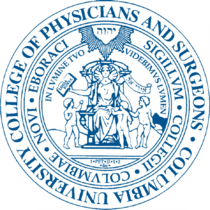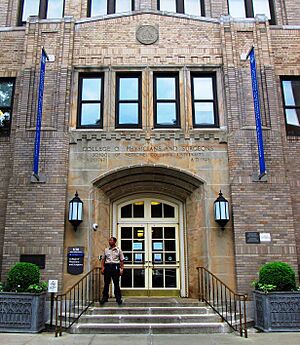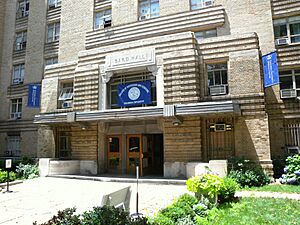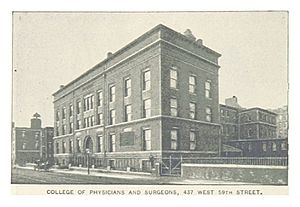Columbia University College of Physicians and Surgeons facts for kids

School seal
|
|
| Type | Private medical school |
|---|---|
| Established | 1767 |
|
Parent institution
|
Columbia University |
| Endowment | $1.136 billion |
| Dean | Katrina Armstrong |
|
Academic staff
|
4,300 |
| Students | Totals: 1,520 606 M.D. 94 M.D./Ph.D. 776 Ph.D. |
| Location |
,
,
United States
40°50′29″N 73°56′28″W / 40.841519°N 73.941139°W |
| Campus | Urban |
| Website | vagelos.columbia.edu/ |
The Columbia University Roy and Diana Vagelos College of Physicians and Surgeons is the medical school of Columbia University. It is located in the Washington Heights area of Manhattan, New York City. This school is part of the Columbia University Irving Medical Center.
It was started in 1767 by Samuel Bard. At that time, it was called the medical department of King's College (which is now Columbia University). It was the first medical school in the Thirteen Colonies to give out the Doctor of Medicine (MD) degree. In 1993, it was also the first U.S. medical school to hold a white coat ceremony. This is a special event where students get their white coats.
In 2017, Roy and Diana Vagelos gave the school $250 million. Because of this gift, in 2018, the school became the first medical school in the country to offer scholarships instead of loans for all students who needed financial help. This means many students can study without worrying about huge debts.
Columbia's medical school works closely with NewYork-Presbyterian Hospital. Students also get to train at other hospitals. These include Harlem Hospital Center, Stamford Hospital in Stamford, CT, and Mary Imogene Bassett Hospital in Cooperstown, NY.
Contents
History of Columbia's Medical School
How the Medical School Started
In 1767, Dr. Samuel Bard started a medical school at King's College. King's College is now known as Columbia University. This was the first medical program in New York and only the second in the American Colonies. The school was designed like the University of Edinburgh Medical School in Scotland, which was a top medical school back then.
In 1770, King's College gave its first medical degree to Robert Tucker. This was the very first Doctor of Medicine (M.D.) degree given in the Thirteen Colonies. Before this, other schools in America and Canada only offered a Bachelor of Medicine degree. The school kept teaching new doctors until 1776. It had to close because of the American Revolutionary War and the British army taking over New York.
The school reopened in 1784 as Columbia College. The medical school teachers were brought back. In 1791, Dr. Bard became the dean of the medical school. George Washington even said Dr. Bard saved his life!
Joining with the College of Physicians and Surgeons
In 1807, a new school called the College of Physicians and Surgeons was started. This was because the young United States needed more trained doctors. Just four years later, in 1811, Dr. Samuel Bard, who was the dean of Columbia's medical school, became the president of this new college.
In 1814, Columbia University Medical School joined with the College of Physicians and Surgeons. This was done to make the medical school stronger. Even after joining, the College of Physicians and Surgeons stayed somewhat independent from Columbia. It wasn't until 1860 that it officially became Columbia University's medical school. At that time, it was located across the street from the Roosevelt Hospital, which was a main teaching hospital.
The College of Physicians and Surgeons became fully part of Columbia in 1891. In 1886, the Sloane Maternity Hospital was founded as part of the school. It later became the Sloane Hospital for Women.
Creating a Medical Center
In 1911, Columbia University made a special agreement with Presbyterian Hospital. This hospital was started in 1868 by a kind person named James Lenox. This agreement helped create a new type of medical center. In 1928, the Columbia-Presbyterian Medical Center opened. A lot of the money for this building came from another kind person, Edward Harkness.
This new center was in the Washington Heights area of Manhattan. It was the first place in the world to have patient care, medical education, and research all in one building. It was a new idea to combine medical training with taking care of patients. Other hospitals joined this project, like the Babies Hospital and the Neurologic Institute of New York.
In 1997, Presbyterian Hospital joined with New York Hospital. This created the NewYork–Presbyterian Hospital. This new hospital system included many smaller hospitals and programs. Even though the two medical schools (Columbia and Cornell) are still separate, they often work together on research and training. All hospitals in the NewYork-Presbyterian Healthcare System are connected to either the Columbia or Cornell medical schools.
A New Name for the School
In 2017, the school was officially renamed the Columbia University Roy and Diana Vagelos College of Physicians and Surgeons. This happened because of a very generous gift of $250 million from Dr. P. Roy and Diana Vagelos.
A big part of this gift, $150 million, was set aside to help medical students. It created a fund to replace student loans with scholarships for students who need financial help. This means more students can become doctors without having to borrow a lot of money. The other $100 million helps support special medicine programs and basic science research. It also helps create a special teaching position in honor of the Vagelos family's doctor and friend, Thomas P. Jacobs, MD.
What Students Learn (Academics)
Starting in 2009, the medical school changed how it teaches. The biggest change was making the first part of medical school shorter. It went from 24 months to 18 months. This gave students more time for elective courses and special projects. Now, every student must spend four to ten months working on a research project before they graduate.
Where the School Is (Campus)
The Columbia University Medical Center is located on land overlooking the Hudson River. It is about fifty blocks away from Columbia's main undergraduate campus. The medical campus has its own special feel.
It includes not only the College of Physicians and Surgeons but also:
- The College of Dental Medicine
- The School of Nursing
- The Mailman School of Public Health
- The Presbyterian part of NewYork-Presbyterian Hospital (including the Morgan Stanley Children's Hospital)
- The New York State Psychiatric Institute
Other hospitals connected to the school are Harlem Hospital, Stamford Hospital in Stamford, Connecticut, and Mary Imogene Bassett Hospital in Cooperstown, New York.
In 2016, a new 14-story glass building opened. It's called the Roy and Diana Vagelos Education Center. It's a modern space for medical education. Students can live on campus in places like Bard Hall and the Bard-Haven Towers. These are three tall apartment buildings with great views of the Hudson River and the George Washington Bridge. Students are guaranteed a place to live on campus, but many choose to live in other parts of New York City.
Student Life
P&S Club
Students at the medical school have many clubs for different interests. All these clubs are part of the P&S Club. One unique group is the Bard Hall Players. This is a theater group run entirely by medical students. It's one of the biggest and most active medical school theater groups in the country. They put on a musical and two plays every year.
The P&S Club was started over a hundred years ago by John Mott, who won the Nobel Peace Prize in 1946. The club helps support activities and groups that make student life better. The P&S Club is also known for its humanitarian work. For example, in 1917, they bought a special boat for a doctor named Sir William Grenfell. He used it to provide medical care to the Inuit and First Nations fishermen living on the Labrador coast. Often, students from the P&S Club helped crew the boat.
Famous People Who Taught Here
Many important people have taught at this medical school. Some have even won the Nobel Prize, like Richard Axel, Eric Kandel, and Joachim Frank. Other famous faculty include:
- Author Oliver Sacks
- Siddhartha Mukherjee, who won a Pulitzer Prize in 2011 for his non-fiction book
- Rudolph Leibel, who helped discover the hormone leptin. This discovery greatly helped us understand human obesity.
- Jean C. Emond, a surgeon who helped with the first living-donor liver transplantation in children in North America. He also started Columbia's liver transplant program, which is now one of the largest in the U.S.
- Joshua Sonett, a surgeon who performed chest surgery on former President Bill Clinton in 2005.
Famous People Who Studied Here
Medical Innovators
Many graduates from this school have made big changes in medicine:
- Virginia Apgar developed the Apgar score, which checks a newborn baby's health.
- Oswald Avery was a pioneer in understanding how our bodies fight diseases.
- Charles Drew did amazing work on blood transfusions and storing blood. He helped create large-scale blood banks.
- William Halsted introduced new surgeries and was one of the "Big Four" founding professors at Johns Hopkins Hospital.
- Robert Lefkowitz won the 2012 Nobel Prize in Chemistry for his work on how cells receive signals.
- Benjamin Spock, a pediatrician, wrote The Common Sense Book of Baby and Child Care, a very famous book for parents.
- Albert Starr, a cardiovascular surgeon, was a pioneer and inventor of the Starr heart valve.
- Allen Whipple developed the Whipple procedure, a major surgery for pancreatic cancer.
Nobel Prize Winners
Several alumni have won the Nobel Prize:
- Baruch Samuel Blumberg
- Joshua Lederberg
- Robert J. Lefkowitz (Nobel Prize in Chemistry 2012)
- Dickinson W. Richards
- Harold Varmus (who also led the National Institutes of Health)
Writers
Some graduates became well-known writers:
- Robert Coles won a Pulitzer Prize.
- Robin Cook has sold over 100 million copies of his books.
- Walker Percy won the National Book Award for Fiction.
Other Notable Alumni
Other alumni include:
- Astronaut Story Musgrave
- Olympic champion swimmer Jenny Thompson (who won twelve medals, including eight gold)
- Former Afghan prime minister Abdul Zahir
- George Fletcher Chandler, who helped organize and was the first leader of the New York State Police.
- Megumi Yamaguchi Shinoda, the first Asian American woman to graduate from the school. She was also one of the first women of Japanese background in the U.S. to get a medical degree.
- John L. Leal helped stop diseases like typhoid fever by using chlorine to clean water.
- Robert Ernest Noble, a U.S. Army medical officer, researched yellow fever and malaria during the building of the Panama Canal.





